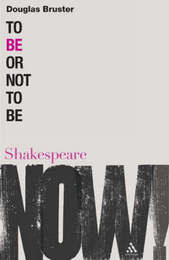
|
To Be or Not to Be
Paperback / softback
Main Details
| Title |
To Be or Not to Be
|
| Authors and Contributors |
By (author) Professor Douglas Bruster
|
| Series | Shakespeare Now! |
|---|
| Physical Properties |
| Format:Paperback / softback | | Pages:128 | | Dimensions(mm): Height 198,Width 129 |
|
| Category/Genre | Drama |
|---|
| ISBN/Barcode |
9780826489982
|
| Classifications | Dewey:822.33 |
|---|
| Audience | | Professional & Vocational | | Postgraduate, Research & Scholarly | | Undergraduate | |
|---|
|
Publishing Details |
| Publisher |
Bloomsbury Publishing PLC
|
| Imprint |
Continuum International Publishing Group Ltd.
|
| Publication Date |
15 February 2007 |
| Publication Country |
United Kingdom
|
Description
Hamlet's "To be or not to be" soliloquy is quoted more often than any other passage in Shakespeare. It is arguably the most famous speech in the Western world - though few of us can remember much about it. This book carefully unpacks the individual words, phrases and sentences of Hamlet's soliloquy in order to reveal how and why it has achieved its remarkable hold on our culture. Hamlet's speech asks us to ask some of the most serious questions there are regarding knowledge and existence. In it, Shakespeare also expands the limits of the English language. Douglas Bruster therefore reads Hamlet's famous speech in "slow motion" to highlight its material, philosophical and cultural meaning and its resonance for generations of actors, playgoers and readers.
Author Biography
Douglas Bruster is Professor of English at The University of Texas at Austin, USA. He is the author of Drama and the Market in the Age of Shakespeare; Quoting Shakespeare; Shakespeare and the Question of Culture; and, with Robert Weimann, Prologues to Shakespeare's Theatre.
Reviews"Douglas Bruster's To Be or Not to Be should delight and instruct anyone who has ever read, seen, or struggled with the central speech of Hamlet...Bruster has done a remarkable job building bridges over notoriously choppy waters, and this book is highly recommended." - Studies in English Literature, Spring 2008 -- Peter G. Platt "[A] fine contribution to our understanding of Shakespeare as artist nonpareil. I was particularly taken with Bruster's insight into the way this 'most resonant presentation of the personal in all of literature' achieves a surprising impersonality by eschewing the use of the first person, making the speech 'float above the rest of the play'." - Michael Taylor, Shakespeare Survey 61 (2008) "The ambitious project of the Shakespeare NOW series is to bridge the gap between 'scholarly thinking and a public audience' and 'public audience and scholarly thinking'. Scholars are encouraged to write in a way accessible to a general readership and readers to rise to the challenge and not be afraid of new ideas and the adventure they offer. There are other bridges the series is ambitious to cross: 'formal, political or theoretical boundaries' - history and philosophy, theory, and performance." English Vol. 58, 2009 "[Shakespeare Now! is] an innovative new series... Series editors Simon Palfry and Ewan Fernie have rejected the notion of business as usual in order to pursue a distinctive strategy that aims to put "cutting-edge scholarship" in front of a broad audience. Shakespeare Now! with its insistent appeal to the contemporary- this is fresh Shakespeare for readers turned off by the prospect of dry-as-dust scholarship-aims to reach a general audience... The book [To Be or Not to Be] commences with an intriguing conceit: Bruster imagines a Shakespeare museum with rooms for different plays. In this fantasized museum, there is an "entire gallery devoted" to Hamlet's famous soliloquy (1). What this gallery offers is a chronological sequence of overlapping performances beginning with the earliest and continuing up to the present. An oral palimpsest is created, as more and more speakers add their voices to the mixture- this idea neatly captures the enormous multiplicity of Hamlets that have come into being, but it also manages to maintain the singularity of the text, despite the differences in presentation (not only embodied performance, but gramophone, film, and video) and even language... To Be or Not To Be is a precisely rendered formalist exercise" -- Shakespeare Quarterly
|